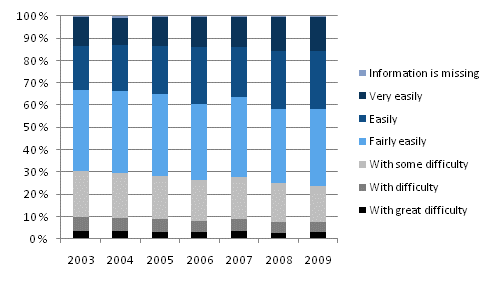Published: 29 December 2010
Number of people with difficulties in making ends meet has decreased
Altogether approximately 600,000 households, or 24 per cent of all households, had difficulties in making ends meet in 2009. Households with major difficulties in making ends meet numbered 190,000, or seven per cent of all households. The number of households finding it difficult to make ends meet decreased by 18 per cent from the year 2003. In real terms, the income of those with difficulties in making ends meet grew more slowly than the average for all households. The annual growth rate from 2003 was 1.2 per cent whereas the average rate for households was 2.2 per cent. This is shown by the data collected in connection with Statistics Finland's income distribution statistics.
Ability to cover regular outlays with income, % of households

Households finding it difficult to cover their regular outlays with their income are defined as households with difficulties in making ends meet. The information is based on the data collected from households on whether they have managed to cover their regular outlays with their income with great difficulties, difficulties, some difficulties, fairly easily, easily or very easily. Some difficulties were experienced by 16.1 per cent, difficulties by 4.5 per cent and great difficulties by just under three per cent of households in 2009. Households finding it very easy to make ends meet numbered 385,000, or 15.2 per cent of all households. The number is approximately one-quarter higher than in 2003.
The households with difficulties in making ends meet most often belong to the lowest-earning income groups. In 2009, disposable income was EUR 27,810 among the households with difficulties in making ends meet and EUR 22,950 among the households with major difficulties in making ends meet whereas the average for the whole population was EUR 38,560. Per consumption unit, the average disposable income, which takes into account differences in consumption needs arising from differences in household structures, was EUR 18,420 among the households with difficulties in making ends meet, EUR 16,080 among the households with major difficulties in making ends meets and EUR 25,480 among the whole households population.
Examined by population group, difficulties in making ends meet are experienced more often than the average by low income earners, households paying high housing costs from their income, unemployed persons, student households, single carer households and under 65-year-old one-person households. Difficulties in making ends meet are notably more widespread in the households of unemployed persons than in other population groups. Altogether 63.5 per cent of the households of unemployed persons found it difficult to make ends meet in 2009. Unlike among other population groups, the share of households with difficulties in making ends meet has not decreased among the households of unemployed persons over the 2003 to 2009 period.
Source: Income Distribution Statistics, Statistics Finland
Inquiries: Marie Reijo (09) 1734 2547, toimeentulo.tilastokeskus@stat.fi
Director in charge: Riitta Harala
- Tables
-
Tables in databases
Pick the data you need into tables, view the data as graphs, or download the data for your use.
Updated 29.12.2010
Official Statistics of Finland (OSF):
Income distribution statistics [e-publication].
ISSN=1799-1331. Subjective financial well-being 2009. Helsinki: Statistics Finland [referred: 27.12.2025].
Access method: http://stat.fi/til/tjt/2009/01/tjt_2009_01_2010-12-29_tie_001_en.html

